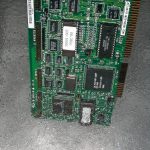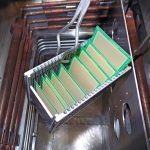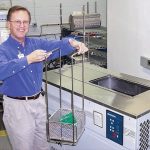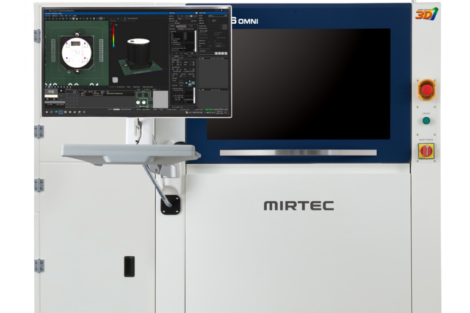The phase-out of the last major ozone-depleting solvent, HCFC-225, finally has been completed. In addition, in many parts of the world, the regulatory pressure on older chlorinated solvents also has increased, so users of nPB, TCE, methylene chloride and other fluids also are migrating to newer, better and safer alternatives.
Mike Jones, MicroCare, New Britain, CT, USA
The good news,” reports David Ferguson, product manager at MicroCare Corp., “is that the industry is meeting the call to develop new cleaning alternatives. In the past two years, we have seen more new chemistries come out of the lab and onto the market than we saw in the entire decade before.” But none of the alternatives are a slam-dunk, according to Barbara Kanegsberg, president of BFK Solutions, a US consulting firm specializing in precision cleaning issues. “Anybody who does not have a cleaning strategy needs to be developing one urgently, and telling his boss to budget for it, right now.”
Montreal Protocol
Life on this planet is protected from dangerous solar radiation by a thin layer of ozone in the upper atmosphere. This layer is constantly in turmoil, with ozone being created and destroyed in relative balance. In the 1970s, it was discovered that synthetic chemicals were depleting this protective barrier faster than nature could restore it. After just a few years of debate, more than 100 nations agreed to the Montreal Protocol1) that set the rules for globally eliminating ozone-depleting substances. The first chemicals banned were the refrigerants, aerosol propellants, blowing agents and precision cleaning solvents called Class I ozone-depleting substances. Now the less damaging Class II solvents have been phased out, and the last among these is HCFC-225.
Thirty-four different HCFCs fluids were developed as interim replacements for the widely popular CFC materials. HCFC-225 was the last of the precision cleaning solvents to be phased-out because it had the lowest projected impact on the ozone layer. This policy was both prudent and practical: HCFC-225 has an ozone-depleting impact approximately only 1/25 of the far more popular CFC-113 fluid. HCFC-225 also is a very good cleaner, nonflammable and fast-drying, VOC-exempt, with a relatively low global warming potential2). Since companies found the transition from CFCs to HCFCs to be relatively painless they made the change fairly quickly, which helped minimize the damage to the ozone layer.
Was the use of HCFCs ever a smart public policy? Many people disagreed with it; Greenpeace describes “the commercial and political influence of the chemical industry” as a major barrier to environmental improvements.3) But Howard Sidebottom and James Franklin in their definitive study wrote that “HCFCs have played an essential role, as interim replacement compounds, in ensuring the speedy elimination of CFCs.”4) So it is a case of the least bad answer, and the EPA (Environment Protection Agency) clearly agreed: one HCFC-225 product received the Best of the Best Stratospheric Ozone Protection Award from them in 1997.5) This pragmatic approach to protecting the environment is the proper path for future efforts, according to MicroCare Corporation’s COO Tom Tattersall. “The teamwork and collaboration behind the Montreal Protocol is the optimal role-model for government-industry co-ordination,” he said.
Why have companies waited so long to make the change away from HCFC-225? Rob Lee, who was at this time Product Manager at DuPont Corp., suspects the main issue is a combination of solvency and materials compatibility. “Companies were hanging on to these cleaners from a compatibility perspective. HCFC-225 is a good cleaner, and it is generally more compatible with materials of construction than the alternatives, plus HCFC-225 has been spec’d in on military projects. Combine all that with the costs of testing and approving a new fluid, and it’s hard to change.” While it has been a long-time coming, this phase-out is important. One expert estimates the reduction in global warming impact may be “the equivalent of removing the climate emissions from 70 million U.S. passenger cars for the next 30 years.6)
Cleaning alternatives
“As a class, HCFCs were remarkable materials,” said David Ferguson. “They were the last group of cleaners that contained chlorine on the molecule, instead of blending a chlorinated solvent to a fluorocarbon to enhance solvency.” This characteristic gave them broad compatibility with moderate solvency. Duplicating those properties with a different molecule is proving to be a challenging task. Most companies that had been using HCFC-225 will find the fastest and easiest transition to be to move to another nonflammable, solvent-based product. Almost all of the new cleaning fluids in their pure form are very stable and mild. To kick up their cleaning power, many suppliers enhance the ingredients with a chlorinated material called trans 1,2 dichloroethylene along with other ingredients. The resulting formulas may form azeotropes which are thermally stable mixtures preferred for their excellent cleaning power, their chemical characteristics, their ease of handling and their compatibility with vapor degreasing.
“But users must do their testing,” Barbara Kanegsberg explains. “The low-boiling alternatives may need major equipment and process changes. The high-boiling blends may leave residues that are hard to remove. Esters can break down and form acids and alcohols. You have to consider the consequences of switching cleaning agents to assure consistent, cost-effective cleaning.” “Companies that could go no-clean went no-clean long ago,” Lee adds. “Companies that could use water are there already. There are complex reasons why companies have stuck with HCFC-225, nPB, TCE and others.“
The contenders
Novec HFE cleaners. For more than 15 years the hydrofluoroethers (HFEs) from 3M Corp. have been available under the Novec brand name. Now an aging technology, they are nonflammable, fast-drying and environmentally acceptable. There are a handful of Novec blends, allowing the cleaning to be tailored to suit the contamination and the application. They are effective in vapor degreasers.
Sion HFO cleaners. Chemours’ Sion is a new HFO (hydrofluoro-olefin) alternative. Pure HFOs are very attractive because they can be a candidate for VOC exemption and they have a medium-low global warming impact. The blended product is a strong cleaner and easily used in a vapor degreaser. Long-term, with a profile near HCFC-225 in terms of equipment design, and a superior environmental and toxicity profile, this may be one of the big winners to replace HCFC-225. This product looks to be the optimal drop-in replacement, requiring only modest changes to temperature settings and cycle times.
Solstice HFO Cleaner is another solvent from Honeywell. A mild cleaner used in its pure form, this product is VOC-exempt by the US EPA and has excellent materials compatibility. However, the Solstice fluid has an ultra-low boiling point (19 °C) which will require expensive retrofits to existing vapor degreasers to keep the fluid trapped inside the cleaning machine. Nonetheless, in some regions, it may be the best alternative acceptable to regulatory agencies.
Tergo Performance Fluids from MicroCare is a new class of choices in the market. These cleaners use a new type of chemistry — sometimes called a co-solvent cleaning process — that is compatible with vapor degreasing but offers greatly expanded solvency. These cleaners have excellent environmental profiles and can be used in high-temperature applications, such as removing buffing compounds or lead-free solders and fluxes.
Vertrel HFC cleaners. First to the market in the late 1990s, Vertrel hydrofluorcarbons (HFCs) from Chemours Corp have been widely accepted as worthy successors to CFCs and HCFCs. Interestingly, the product line includes more than 20 different formulations. This allows Chemours to tackle more varied types of contamination and different regulatory environments than the HFE cleaners.
At this point, one option to seriously study and possibly avoid is any brominated or chlorinated solvent. These products are highly effective precision cleaners with very attractive prices. However, the toxicity standards for these products are being tightened and their use will become problematic. Brominated solvents (also called nPB and featuring a cleaner with the CAS number #106–94–5) are marketed under the brand names of Absolv, Bromothane, DrySolv, EnSolv, EnTron, LekSolv, Lenium, Metalnox, Solvon and others.7) Tricholoethylene (also called TCE or trike) is under great scrutiny in the USA. For most companies, it makes no sense to transition into another problematic cleaner that might only have 18–24 months of useful life on the market.
Cleaning conversion plan
What’s the best way to migrate to a new cleaning solvent? There are four steps in solving this puzzle. First, do your internal research. Conduct an internal cleaning audit to determine which products in their warehouses and tool cribs contain HCFC-225, nPB, TCE or the other cleaning fluids scheduled to be eliminated in the next few years. For example, HCFC-225 can be found in drums, pails, glass bottles and even in aerosol cleaners. Determine who in your facility is using these products. Collecting the details about each cleaning application will help narrow the search for a proper replacement.
Companies also should take the time to consider the effectiveness of their current cleaning process. Is the current cleaner doing everything it should? Is it fast enough, reliable enough and is the cost-per-part cleaned affordable? What’s the future of this project – will we still be making this module in five years? This is also a good time to review the cleanliness specification – how clean is clean enough?
Once you have your house in order, it’s time to start reviewing the candidates. Read and understand the SDS and the product specifications available online. Contact the main vendors to get samples of prospective new cleaners that meet the cleaning criteria. Vendors should be willing to send small samples at no charge, such as liters and gallons. With samples of this size the effectiveness of the cleaner can be evaluated, and materials compatibility can be tested as well. Having pruned the list of choices, it’s now time to prepare product samples and send them to the vendors’ labs for cleaning evaluations. Bundle up a significant quantity of soiled parts and package them in clean, airtight packages for shipment to the cleaner vendors. Be as generous as you can with samples for testing, as a lack of test parts can affect the accuracy of the lab work. Usually, one cleaning fluid will prove to be the optimal answer.
Based on the results from the lab, clients might want to fine-tune their expectations with more in-depth cleaning tests, conduct large-scale cleaning tests in their own systems, or to vary the cleaning hardware to see if the results might shift. Once that’s done, work with top management to fund and schedule the transition.
SMT Hybrid Packaging, Booth 4-301
Share:












